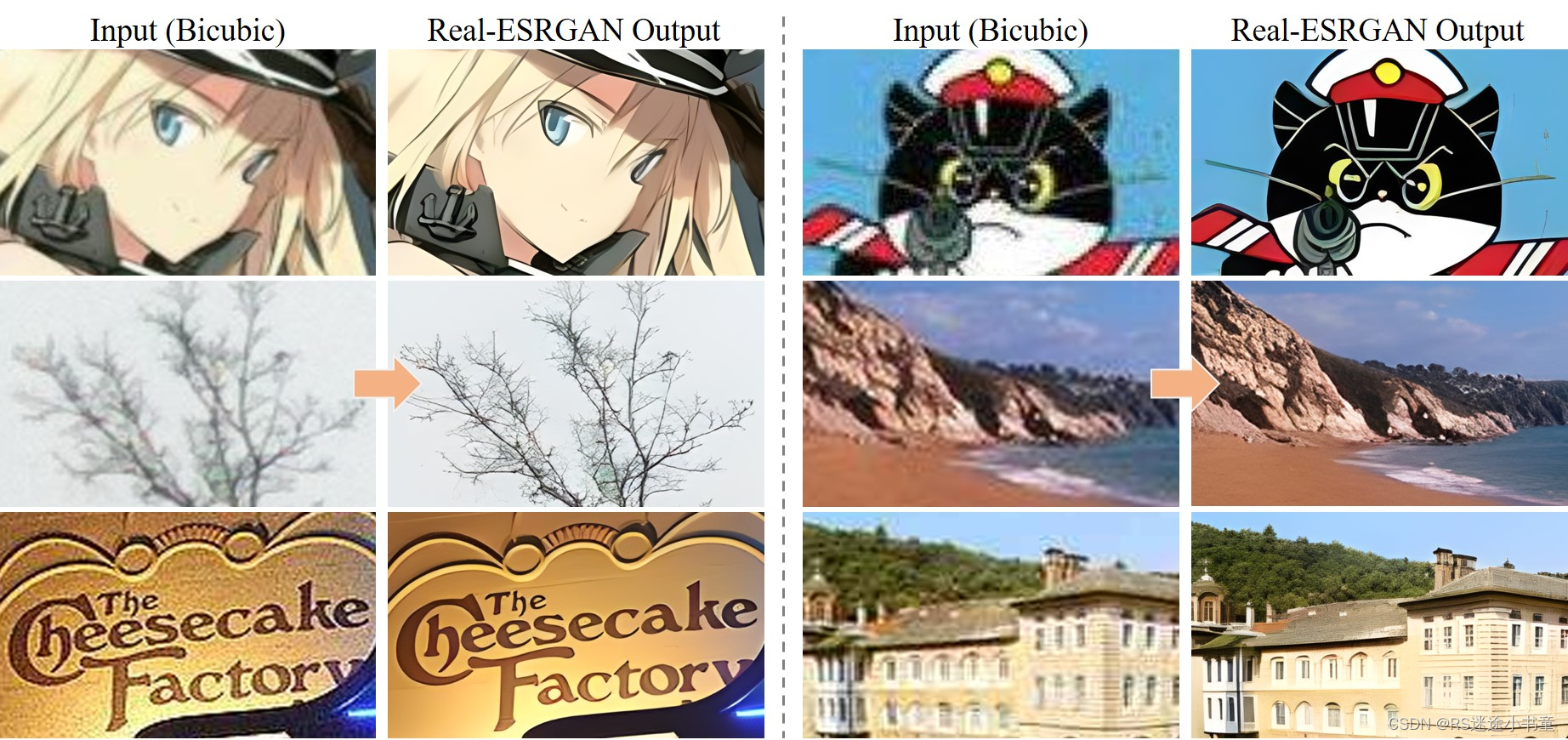1 前言
图像超分是一种图像处理技术,旨在提高图像的分辨率,使其具有更高的清晰度和细节。这一技术通常用于图像重建、图像恢复、图像增强等领域,可以帮助我们更好地理解和利用图像信息。图像超分技术可以通过多种方法实现,包括插值算法、深度学习等。其中,深度学习的方法在近年来得到了广泛的关注和应用。基于深度学习的图像超分技术,可以利用深度神经网络学习图像的高频部分,从而提高了图像的分辨率和清晰度。
目前应用较多的应用场景是图像及视频分辨率提高,比如可以提高以往影视作品或图像的分辨率,提高视觉感官效果;或是解决视频经有损压缩后导致视频效果退化问题。今天给大家介绍一下腾讯ARC实验室发布的一个图像超分辨率模型Real-ESRGAN:项目开源地址,论文地址。
1.1 项目效果展示

2 Python代码使用教程
2.1 依赖库安装
- Python >= 3.7 (推荐使用Anaconda或Miniconda)
- PyTorch >= 1.7
- 这里比较推荐大家用离线本地安装
2.1.1 项目安装
git clone https://github.com/xinntao/Real-ESRGAN.git
cd Real-ESRGAN2.1.2 安装依赖
# 安装 basicsr - https://github.com/xinntao/BasicSR
# 我们使用BasicSR来训练以及推断
pip install basicsr
# facexlib和gfpgan是用来增强人脸的
pip install facexlib
pip install gfpgan
pip install -r requirements.txt
python setup.py develop2.2 模型介绍
模型下载链接,里面有7个,有些我不知道是干啥用的,所以就没说。
- realesrgan-x4plus(默认)
- reaesrnet-x4plus
- realesrgan-x4plus-anime(针对动漫插画图像优化,有更小的体积)
- realesr-animevideov3 (针对动漫视频)
2.3 代码使用
将下载好的模型,放在项目文件中的weights文件夹中,然后打开inference_realesrgan.py和inference_realesrgan_video.py这两个文件就运行就行了,一个是图片超分,一个是视频超分。我这里将代码已经全部注释了,自己可以看看很好理解。
默认模型是realesrgan-x4plus,需要超分的图片/视频放在项目文件夹的inputs中,输出在results中。
import argparse
import cv2
import glob
import os
from basicsr.archs.rrdbnet_arch import RRDBNet
from basicsr.utils.download_util import load_file_from_urlfrom realesrgan import RealESRGANer
from realesrgan.archs.srvgg_arch import SRVGGNetCompactdef main():"""Inference demo for Real-ESRGAN."""parser = argparse.ArgumentParser() # 创建一个命令行解析器对象,用于解析命令行参数parser.add_argument('-i', '--input', type=str, default='inputs', help='Input image or folder')# 添加一个命令行参数 -i, --input,类型为字符串,默认值为 'inputs',用于指定输入图像或文件夹parser.add_argument('-n','--model_name',type=str,default='RealESRGAN_x4plus',help=('Model names: RealESRGAN_x4plus | RealESRNet_x4plus | RealESRGAN_x4plus_anime_6B | RealESRGAN_x2plus | ''realesr-animevideov3 | realesr-general-x4v3'))# 添加一个命令行参数 -n, --model_name,类型为字符串,默认值为 'RealESRGAN_x4plus',用于指定使用的模型名称parser.add_argument('-o', '--output', type=str, default='results', help='Output folder')# 添加一个命令行参数 -o, --output,类型为字符串,默认值为 'results',用于指定输出文件夹parser.add_argument('-dn','--denoise_strength',type=float,default=0.5,help=('Denoise strength. 0 for weak denoise (keep noise), 1 for strong denoise ability. ''Only used for the realesr-general-x4v3 model'))# 添加一个命令行参数 -dn, --denoise_strength,类型为浮点数,默认值为 0.5,用于指定去噪强度parser.add_argument('-s', '--outscale', type=float, default=4, help='The final upsampling scale of the image')# 添加一个命令行参数 -s, --outscale,类型为浮点数,默认值为 4,用于指定最终的放大倍数parser.add_argument('--model_path', type=str, default=None, help='[Option] Model path. Usually, you do not need to specify it')# 添加一个命令行参数 --model_path,类型为字符串,默认值为 None,用于指定模型路径。通常不需要指定。parser.add_argument('--suffix', type=str, default='out', help='Suffix of the restored image')# 添加一个命令行参数 --suffix,类型为字符串,默认值为 'out',用于指定输出图像的后缀parser.add_argument('-t', '--tile', type=int, default=0, help='Tile size, 0 for no tile during testing')# 添加一个命令行参数 -t, --tile,类型为整数,默认值为 0,用于指定瓦片大小。0 表示测试时没有瓦片。parser.add_argument('--tile_pad', type=int, default=10, help='Tile padding')# 添加一个命令行参数 --tile_pad,类型为整数,默认值为 10,用于指定瓦片填充大小parser.add_argument('--pre_pad', type=int, default=0, help='Pre padding size at each border')# 添加一个命令行参数 --pre_pad,类型为整数,默认值为 0,用于指定每个边界的预填充大小parser.add_argument('--face_enhance', action='store_true', help='Use GFPGAN to enhance face')# 添加一个命令行参数 --face_enhance,动作是存储为 True,用于指定是否使用 GFPGAN 来增强人脸parser.add_argument('--fp32', action='store_true', help='Use fp32 precision during inference. Default: fp16 (half precision).')# 添加一个命令行参数 --fp32,动作是存储为 True,用于指定推理期间是否使用 fp32 精度。默认情况下使用 fp16(半精度)parser.add_argument('--alpha_upsampler',type=str,default='realesrgan',help='The upsampler for the alpha channels. Options: realesrgan | bicubic')# 添加一个命令行参数 --alpha_upsampler,类型为字符串,默认值为 'realesrgan',用于指定 alpha 通道的上采样器。选项:realesrgan | bicubicparser.add_argument('--ext',type=str,default='auto',help='Image extension. Options: auto | jpg | png, auto means using the same extension as inputs')# 添加一个参数,参数名为'--ext',类型为字符串,默认值为auto,这个参数主要用于指定输入图像的扩展名。parser.add_argument('-g', '--gpu-id', type=int, default=None, help='gpu device to use (default=None) can be 0,1,2 for multi-gpu')# 添加一个参数,参数名为'-g'或'--gpu-id',类型为整数,默认值为None。这个参数主要用于指定使用的GPU设备。args = parser.parse_args()# 解析命令行参数,生成一个命名空间args# determine models according to model namesargs.model_name = args.model_name.split('.')[0]# 根据传入的命令行参数--model-name来选择模型,这里假设模型名称和使用的模型之间的关系已经预设好。if args.model_name == 'RealESRGAN_x4plus': # x4 RRDBNet modelmodel = RRDBNet(num_in_ch=3, num_out_ch=3, num_feat=64, num_block=23, num_grow_ch=32, scale=4)netscale = 4file_url = ['https://github.com/xinntao/Real-ESRGAN/releases/download/v0.1.0/RealESRGAN_x4plus.pth']elif args.model_name == 'RealESRNet_x4plus': # x4 RRDBNet modelmodel = RRDBNet(num_in_ch=3, num_out_ch=3, num_feat=64, num_block=23, num_grow_ch=32, scale=4)netscale = 4file_url = ['https://github.com/xinntao/Real-ESRGAN/releases/download/v0.1.1/RealESRNet_x4plus.pth']elif args.model_name == 'RealESRGAN_x4plus_anime_6B': # x4 RRDBNet model with 6 blocksmodel = RRDBNet(num_in_ch=3, num_out_ch=3, num_feat=64, num_block=6, num_grow_ch=32, scale=4)netscale = 4file_url = ['https://github.com/xinntao/Real-ESRGAN/releases/download/v0.2.2.4/RealESRGAN_x4plus_anime_6B.pth']elif args.model_name == 'RealESRGAN_x2plus': # x2 RRDBNet modelmodel = RRDBNet(num_in_ch=3, num_out_ch=3, num_feat=64, num_block=23, num_grow_ch=32, scale=2)netscale = 2file_url = ['https://github.com/xinntao/Real-ESRGAN/releases/download/v0.2.1/RealESRGAN_x2plus.pth']elif args.model_name == 'realesr-animevideov3': # x4 VGG-style model (XS size)model = SRVGGNetCompact(num_in_ch=3, num_out_ch=3, num_feat=64, num_conv=16, upscale=4, act_type='prelu')netscale = 4file_url = ['https://github.com/xinntao/Real-ESRGAN/releases/download/v0.2.5.0/realesr-animevideov3.pth']elif args.model_name == 'realesr-general-x4v3': # x4 VGG-style model (S size)model = SRVGGNetCompact(num_in_ch=3, num_out_ch=3, num_feat=64, num_conv=32, upscale=4, act_type='prelu')netscale = 4file_url = ['https://github.com/xinntao/Real-ESRGAN/releases/download/v0.2.5.0/realesr-general-wdn-x4v3.pth','https://github.com/xinntao/Real-ESRGAN/releases/download/v0.2.5.0/realesr-general-x4v3.pth']# determine model pathsif args.model_path is not None:# 判断是否传入了模型路径,如果传入了则直接使用该路径,否则会结合模型名称生成一个默认的模型路径model_path = args.model_pathelse:model_path = os.path.join('weights', args.model_name + '.pth')if not os.path.isfile(model_path):ROOT_DIR = os.path.dirname(os.path.abspath(__file__))for url in file_url:# model_path will be updatedmodel_path = load_file_from_url(url=url, model_dir=os.path.join(ROOT_DIR, 'weights'), progress=True, file_name=None)# use dni to control the denoise strengthdni_weight = None# dni_weight 为 None 表示不使用 DNI# 如果使用了 DNI,dni_weight 的值会是一个列表,列表的两个元素分别代表 DNI 网络和原始模型的权重if args.model_name == 'realesr-general-x4v3' and args.denoise_strength != 1:wdn_model_path = model_path.replace('realesr-general-x4v3', 'realesr-general-wdn-x4v3')model_path = [model_path, wdn_model_path]dni_weight = [args.denoise_strength, 1 - args.denoise_strength]# restorerupsampler = RealESRGANer(scale=netscale, # 放大倍率,即超分辨率的因子model_path=model_path, # 预训练模型的路径dni_weight=dni_weight, # DNI网络的权重,用于控制去噪强度(Denoising Network Integration)model=model, # 输入模型,一般是降噪后的图像tile=args.tile, # 分块大小,即将图像切割成多个小块进行超分辨率tile_pad=args.tile_pad, # 块与块之间的填充大小pre_pad=args.pre_pad, # 预处理时的填充大小half=not args.fp32, # 是否使用半精度浮点数进行计算,若args.fp32为True则使用半精度,否则使用全精度gpu_id=args.gpu_id) # GPU的ID,用于在多GPU环境下指定使用哪个GPU进行计算if args.face_enhance: # Use GFPGAN for face enhancement,如果需要使用 GFPGAN 进行人脸增强from gfpgan import GFPGANer # 导入 GFPGAN 人脸增强器的类face_enhancer = GFPGANer(model_path='https://github.com/TencentARC/GFPGAN/releases/download/v1.3.0/GFPGANv1.3.pth',upscale=args.outscale, # 放大倍率,即超分辨率的因子arch='clean', # GFPGAN的架构,这里选择的是'clean'版本channel_multiplier=2, # 通道的乘数,用于扩大模型的通道数bg_upsampler=upsampler) # 使用之前创建的RealESRGAN超分辨率增强器作为背景超分辨率增强器# args.output = r"G:\Anaconda\ProjectYOLO\yolov5-7.0\Real-ESRGAN-master\1/"os.makedirs(args.output, exist_ok=True) # 创建输出目录,如果已存在则不报错,继续执行后续代码if os.path.isfile(args.input):# 判断输入路径是否为一个文件paths = [args.input]# 如果是文件,直接将其路径加入到paths列表中else:paths = sorted(glob.glob(os.path.join(args.input, '*')))# 如果输入路径不是一个文件,那么它应该是一个包含图像的文件夹# 使用glob库获取输入路径下所有的文件路径,并将它们按字母顺序排序后加入到paths列表中for idx, path in enumerate(paths):# 遍历所有的文件路径imgname, extension = os.path.splitext(os.path.basename(path)) # 获取文件名和扩展名print('Testing', idx, imgname) # 打印正在处理的文件信息img = cv2.imread(path, cv2.IMREAD_UNCHANGED)# 使用OpenCV读取图片,参数cv2.IMREAD_UNCHANGED表示以最接近原始图像的颜色空间读取图像if len(img.shape) == 3 and img.shape[2] == 4:# 判断图像的维度,如果维度为3且第三个维度的大小为4,说明图像是RGBA格式的,否则不进行特殊处理img_mode = 'RGBA' # 记录图片模式为RGBAelse:img_mode = None # 否则不记录图片模式try:if args.face_enhance:# 如果需要人脸增强,使用face_enhancer进行人脸增强处理,参数包括输入图像、是否进行人脸对齐、是否只处理中心的人脸部分以及是否将处理后的人脸粘贴回原图_, _, output = face_enhancer.enhance(img, has_aligned=False, only_center_face=False, paste_back=True)else:# 否则,使用upsampler进行图像超分辨率增强,参数包括输入图像、放大倍数以及是否使用GPU加速output, _ = upsampler.enhance(img, outscale=args.outscale)except RuntimeError as error:# 如果在处理过程中出现RuntimeError异常,打印错误信息,并给出可能的解决方案print('Error', error)print('If you encounter CUDA out of memory, try to set --tile with a smaller number.')else:# 如果没有出现异常,执行else分支的代码# 如果用户没有指定输出文件的扩展名,则自动从输入文件的扩展名中获取输出文件的扩展名;否则使用用户指定的扩展名if args.ext == 'auto':extension = extension[1:]else:extension = args.extif img_mode == 'RGBA': # RGBA images should be saved in png format# 如果图片的模式是RGBA,说明图片是RGBA格式的,需要将其保存为png格式的图片extension = 'png'if args.suffix == '':# 根据用户指定的后缀名构造保存路径save_path = os.path.join(args.output, f'{imgname}.{extension}')else:save_path = os.path.join(args.output, f'{imgname}_{args.suffix}.{extension}')# 使用OpenCV将处理后的图片保存到指定路径下,参数指定保存的文件格式和压缩质量等选项(这里没有指定压缩质量)cv2.imwrite(save_path, output)# 保存处理后的图片到指定路径下if __name__ == '__main__':main()
2.4 命令行使用
2.4.1 参数
Usage: python inference_realesrgan.py -n RealESRGAN_x4plus -i infile -o outfile [options]...A common command: python inference_realesrgan.py -n RealESRGAN_x4plus -i infile --outscale 3.5 --face_enhance-h show this help-i --input Input image or folder. Default: inputs-o --output Output folder. Default: results-n --model_name Model name. Default: RealESRGAN_x4plus-s, --outscale The final upsampling scale of the image. Default: 4--suffix Suffix of the restored image. Default: out-t, --tile Tile size, 0 for no tile during testing. Default: 0--face_enhance Whether to use GFPGAN to enhance face. Default: False--fp32 Whether to use half precision during inference. Default: False--ext Image extension. Options: auto | jpg | png, auto means using the same extension as inputs. Default: auto2.4.2 参数使用
python inference_realesrgan.py -n RealESRGAN_x4plus_anime_6B -i inputs3 桌面端轻应用
作者提供了打包好的桌面端exe程序,无需配置PyTorch等依赖,Windows下载地址。
使用方法也很简单,图片放在realesrgan-ncnn-vulkan.exe同目录下,然后使用cmd命令行跳转至这个目录,输入下面的命令(自己修改)。
./realesrgan-ncnn-vulkan.exe -i 输入图像.jpg -o 输出图像.png -n 模型名字 注意:可执行文件并没有支持 python 脚本 inference_realesrgan.py 中所有的功能,比如 outscale 选项) .
Usage: realesrgan-ncnn-vulkan.exe -i infile -o outfile [options]...-h show this help-i input-path input image path (jpg/png/webp) or directory-o output-path output image path (jpg/png/webp) or directory-s scale upscale ratio (can be 2, 3, 4. default=4)-t tile-size tile size (>=32/0=auto, default=0) can be 0,0,0 for multi-gpu-m model-path folder path to the pre-trained models. default=models-n model-name model name (default=realesr-animevideov3, can be realesr-animevideov3 | realesrgan-x4plus | realesrgan-x4plus-anime | realesrnet-x4plus)-g gpu-id gpu device to use (default=auto) can be 0,1,2 for multi-gpu-j load:proc:save thread count for load/proc/save (default=1:2:2) can be 1:2,2,2:2 for multi-gpu-x enable tta mode"-f format output image format (jpg/png/webp, default=ext/png)-v verbose output由于这些exe文件会把图像分成几个板块,然后来分别进行处理,再合成导出,输出的图像可能会有一点割裂感(而且可能跟PyTorch的输出不太一样)。
4 总结
这个开源项目总体来说精度是不错的,图像的分辨率确实有明显的提升,可以将模糊的图片还原出更多的细节,但有时候的效果比较抽象。作者在项目中说会持续更新(PS:作者的重心好像是放在动漫图片超分方面),希望会越来越好。最后分享一下腾讯ARC的Web端使用demo。







)





:视图)
)




